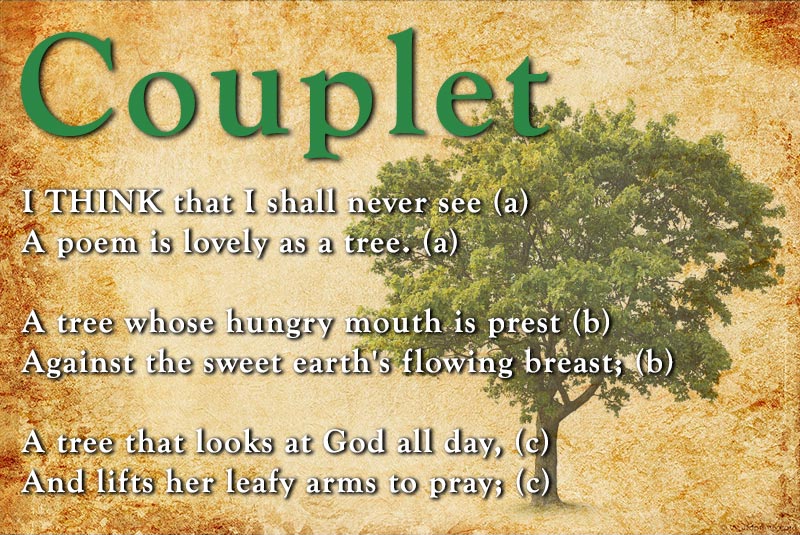A couplet is a type of poem that contains pairs of rhyming lines (rhyming stanzas) that are of a similar length and have the same rhythmic structure, which is known in poetry as meter. The rhyming words in a couplet are typically placed as the last word of each line.

While the typical couple rhyme pattern is aa, the pair of lines don't need to have a rhyme scheme at all, as it is common for them to be used as a space-filler between lines that do rhyme. The lines can be written in succession or have a line or two placed in between them that does not have the same rhyme structure.
A couplet can be written in a formal tone that signals a pause at the end of each line indicating the end of a phrase, or as a run-on that uses the two lines to finish one continuous thought.
Types of Couplets
Elegiac couplet
Elegiac Couplets are a poetic form used by Greek lyric poets having a pair of lines consisting of a dactylic hexameter and dactylic pentameter. The first line is in dactylic hexameter, and the second is in dactylic pentameter.
A Heroic Couplet is a traditional form of English poetry, commonly used for epic and narrative poetry. It refers to poems constructed from a sequence of rhyming pairs of iambic pentameter lines.
Split Couplet
Split Couplets have an initial line written in iambic pentameter and a second line written in iambic dimeter. This gives the lines an asymmetrical rhythm.
Open Couplet
An Open Couplet, also known as a "run-on" couplet, is a pair of lines in a poem where the first line ends partway through a sentence (enjambment), causing the sentence to continue on the following line.
Example of an Open Couplet: The Waste Land by T.S. Eliot
April is the cruelest month, breeding
Lilacs out of the dead land, mixing
Memory and desire, stirring
Dull roots with spring rain.
Winter kept us warm, covering
Earth in forgetful snow, feeding
Closed Couplet
Example of a Closed Couplet: Do Not Stand at My Grave and Weep by Mary Elizabeth Frye.
Do not stand at my grave and weep
I am not there; I do not sleep.
I am a thousand winds that blow,
I am the diamond glints on snow,
I am the sun on ripened grain,
I am the gentle autumn rain.
When you awaken in the morning’s hush
I am the swift uplifting rush
Of quiet birds in circled flight.
I am the soft stars that shine at night.
Do not stand at my grave and cry,
I am not there; I did not die.
Chinese Couplet
An Antithetical couplet.
Qasida
Qasida is a Persian/Arabic style of poetry having 15 to 100 couplets, even more. It is an epic poem centered on praise, boasting, satire and blame, and other issues such as nature.
Couplet Examples
Trees (an excerpt)
I THINK that I shall never see (a)
A poem is lovely as a tree. (a)
A tree whose hungry mouth is prest (b)
Against the sweet earth's flowing breast; (b)
- by Joyce Kilmer
One common note on either lyre did strike, (a)
And knaves and fools we both abhorred alike. (a)
To the same goal did both our studies drive; (b)
The last set out the soonest did arrive. (b)
Thus Nisus fell upon the slippery place, (c)
While his young friend performed and won the race. (c)
- by John Dryden
Related Terms
antistrophe, book, both, brace, burden, canto, chorus, couple, distich, double harness, doublet, duad, duet, duo, dyad, envoi, epode, heptastich, hexastich, line, match, mates, measure, monostich, octastich, octave, octet, ottava rima, pair, pentastich, q